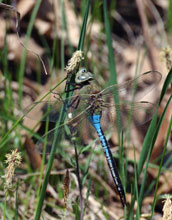Multimedia Gallery
Green Darner Dragonfly Anax junius
Green Darner Dragonfly Anax junius
Common green darner dragonfly (Anax junius) in Afton State Park, Minnesota, one of the largest species of dragonflie. Green darner's prefer still or very slow-moving fresh water, with lots of aquatic vegetation such as lakes and ponds and rivers and streams, and can only flourish where there are no predatory fish. Green darners feed on many insects that are harmful to humans and the environment, especially mosquitoes. While the species is fairly common and abundant throughout its range, the main threat to their persistence is destruction of the freshwater habitat they require to breed. (Date of Image: May 3, 2003) [One of two related images. See Next Image.]
More about this Species
Green darners are one of the largest dragonflie species, with males ranging in size from 70-76 millimeters in length to 90-104 millimeters in expanse, and females from about 68-80 millimeters in length to 90-106 millimeters in expanse. Both sexes are characterized by a green thoracic region and a reddish-brown coloration ventrally in the abdominal region, with the female having slightly lighter coloration, and have light blue abdominal coloration dorsally. Nymphs are fully aquatic, six-legged, with large lateral eyes, elongate wingpads and underslung mouthparts.
The breeding area of the green darner ranges from the northernmost part of the United States (Alaska) all the way south to Panama, may also occur from Hawaii east to Nova Scotia and in the West Indies and Tahiti, and are also known to occur in Asia, from Kamchatka south to Japan and mainland China.
Reproduction usually occurs in the summer months of July and August. The breeding behavior of males includes their selecting a territory that is attractive to females, which they must defend from other would-be mates. Males are often observed holding races over ponds and duel in spectacular aerial battles for the rights to mate with the female darners in that territory.When they hatch, green darner nymphs are wholly carnivorous, usually eating aquatic insects, tadpoles and very small fish. Adult darners catch and eat insects on the wing, including moths and mosquitos. Dragonflies are excellent aerial hunters, due to their tremendous flying speed (recorded at up to 18 mph) and incredible eyesight. They use their powerful jaws to tear apart and chew up their prey. [Information taken from the University of Michigan's Animal Diversity Web site.] Further information about the green darner can be found in the National Science Foundation's "The Secret Life of Animals" Special Report.
Credit: Phil Myers (photographer, copyright holder), Museum of Zoology, University of Michigan Animal Diversity Web site (http://animaldiversity.org)
Special Restrictions: This image may be used for educational fair use; for other uses, please contact the copyright holder.
Images and other media in the National Science Foundation Multimedia Gallery are available for use in print and electronic material by NSF employees, members of the media, university staff, teachers and the general public. All media in the gallery are intended for personal, educational and nonprofit/non-commercial use only.
Images credited to the National Science Foundation, a federal agency, are in the public domain. The images were created by employees of the United States Government as part of their official duties or prepared by contractors as "works for hire" for NSF. You may freely use NSF-credited images and, at your discretion, credit NSF with a "Courtesy: National Science Foundation" notation.
Additional information about general usage can be found in Conditions.
Also Available:
Download the high-resolution JPG version of the image. (1.7 MB)
Use your mouse to right-click (Mac users may need to Ctrl-click) the link above and choose the option that will save the file or target to your computer.

